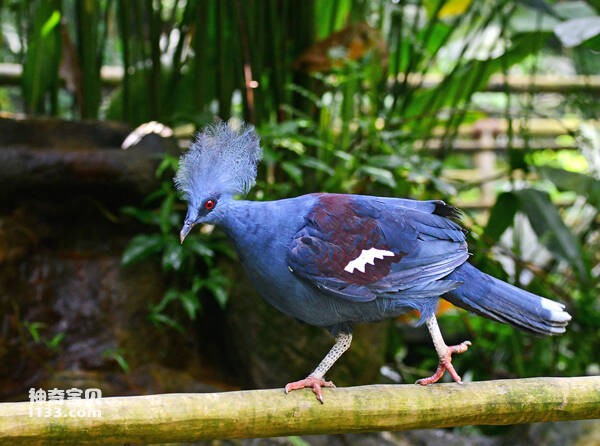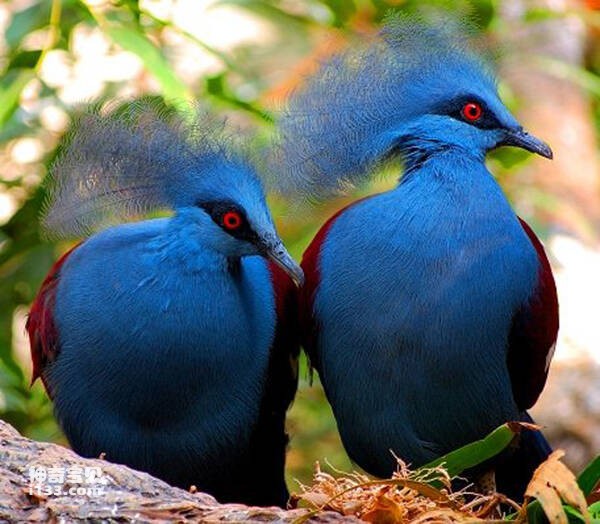Goura cristata
IUCN
LCBasic Information
Scientific classification
- name:Goura cristata
- Scientific Name:Goura cristata,Blue Crowned Pigeon
- Outline:Landfowl
- Family:
Vital signs
- length:70-75CM
- Weight:1.8-2.4kg
- lifetime:No textual research information is available
Feature
It is the most beautiful member of the pigeon family and the largest of the pigeons, almost as big as a Turkey
Distribution and Habitat
It is found in Indonesia.
It is found in near-water and partially flooded forests, swampy areas, and hilly forests below 350 m above sea level, but also in forests with dense secondary growth and mangroves.
Appearance
The blue crested dove is 70-75 cm long and weighs 1800-2400 grams. The species challenges the conventional wisdom of the pigeon, the world's largest pigeon, which is the size of a small Turkey and is actually a close relative of the globular dodo, but it is also one of the most beautiful pigeons. Both sexes are similar. It has a slender beak and dark blue feathers that extend to the eyes and cheeks. The whole body is blue, the feathers are smooth and neat, there is a white area on the tail and under the wings, and the middle part of the wings to the front breast is slightly purple, the red eyes are bright, the feathers around the eyes are darker, and the legs have small spots. The blue crested dove has four toes on each foot, three forward and one back. The most striking thing about the blue crested dove is the light blue fan-shaped crest that stands on its head. Both sexes have this patch of feathers, which are worn on their heads like a crested cap. During the breeding season, t
Details
The Blue Crowned Pigeon (Goura cristata) has three subspecies.

The blue crested dove is a resident bird. A bird's nest is built in a tree. They usually live and forage in small groups of 2-10, searching for fallen fruits and seeds, as well as eating any insects they encounter. Like a pheasant. The staple food is seeds, fruits and insects of various plants. The breeding season of the blue crested dove is in the spring, during which the male and female birds fan out their crests to delight each other.
Blue crested dove's head stands a light blue fan-like crown, both sexes have this patch of feathers, like a wind crown on the head. During breeding, male and female blue crested doves fan out their crown feathers to each other, the male birds call loudly, bow, display their fan tail and partially open wings, and also dance with their wings extended upward, while the female birds raise their wings high and circle around the male. The male will then show the female the nesting material he has prepared, and together they will build a simple disc-shaped nest in the tree. The female birds lay 1 white egg the size of a pigeon egg in each clutch. The incubation time is female birds at night and male birds take turns during the day. The incubation period is 28 days. The chicks are late sex, and the parent birds will secrete pigeon milk to feed the chicks for a month. When the birds mature, the parents continue to feed them for several months. The young stay with their parents until the second year and begin to live independently.

The blue crested dove is hunted in large numbers by humans for food and for its beautiful feathers (although in smaller numbers than the other two species because gun ownership in Indonesia is lower than in Papua New Guinea) and may be affected by "significant" levels of trade, with extensive logging concessions already granted throughout its range, And habitat loss has been destroyed by substantial migration programs. Road construction and oil and mineral exploration have also increased hunter incursions and killings. Like the purple-breasted Crested Dove and the Crested Crested dove, this species may no longer be common in logging forests (2016). Conservation actions are ongoing and the species is protected in Indonesia for commercial trade and domestic use. All of West Papua has a single protected area, and there are three very large nature reserves in the interior of Papua, but most are in the mountains.
Protect wild animals and eliminate wild meat.
Maintaining ecological balance is everyone's responsibility!








